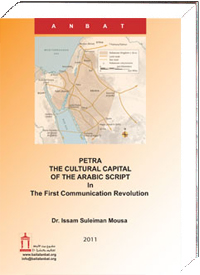

This book by Issam Mousa employs the historical critical communication theory to prove that
the Arabic script in use today by Arabs evolved from the Nabataean script of
Communication Scholars believe that the development of the alphabet is a cornerstone of the present civilization. This invention was marked by historians as the First Communication Revolution. Its outcome was the development of the Alphabet in the
Both Latin and Arabic alphabets, and thus scripts, are derived from the Canaanite-Phoenician alphabet, which represents a shared cultural heritage between the
However, most philologists suggest that the second-most-used alphabet in the world after Latin, i.e.
Arabic, has descended from the Nabataean, while few say that it descended from the Syriac. Both Nabataean and Syriac are derived from the Phoenician script.
The author, in this book, proves that the Arabic alphabet descended from the Nabataean. To him, the Nabataeans were a unique nation that became organized and were able to develop their political system into the first Arab Kingdom in history, which ruled for about five centuries, over a vast area in the Middle East, until 106 A.D. when
In brief, this work
by Issam Mousa attempts to reconstruct their history in the light of the critical communication theory, to prove that
.

